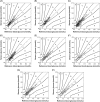A head-to-head comparison of personal and professional continuous glucose monitoring systems in people with type 1 diabetes: Hypoglycaemia remains the weak spot
- PMID: 30484947
- PMCID: PMC6590188
- DOI: 10.1111/dom.13598
A head-to-head comparison of personal and professional continuous glucose monitoring systems in people with type 1 diabetes: Hypoglycaemia remains the weak spot
Abstract
To compare the performance of a professional continuous glucose monitoring (proCGM) and a personal continuous glucose monitoring (persCGM) system worn in parallel under standardized conditions in individuals with type 1 diabetes (T1D), two CGM systems (iPro2 - proCGM; Minimed 640G - persCGM) worn in parallel using the same sensor (Enlite 2) were compared. Ten people with T1D were included in this single-centre, open-label study in which CGM performance was evaluated. The study consisted of a 24-hours inpatient phase (meals, exercise, glycaemic challenges) and a 4-day home phase. Analyses included fulfilment of ISO 15197:2013 criteria, mean absolute relative difference (MARD), Parkes Error Grid and Bland-Altman plots. During the inpatient stay, ISO 15197:2013 criteria fulfilment was 58.4% (proCGM) and 57.8% (persCGM). At home, the systems met ISO 15197:2013 criteria by 66.5% (proCGM) and 65.3% (persCGM). No difference of MARD in inpatient phase (19.1 ± 16.7% vs. 19.0 ± 19.6; P = 0.83) and home phase (18.6 ± 26.8% vs. 17.4 ± 21.3%, P = 0.87) was observed. All sensors performed less accurately during hypoglycaemia. ProCGM and persCGM showed similar performance during daytime and night-time for the inpatient and the home phase. However, sensor performance was reduced during hypoglycaemia for both systems.
Keywords: clinical trial; continuous glucose monitoring (CGM); hypoglycaemia; type 1 diabetes.
© 2018 The Authors. Diabetes, Obesity and Metabolism published by John Wiley & Sons Ltd.
Conflict of interest statement
Author contributions
O.M. and M.P. drafted the manuscript. T.R.P., H.S. and J.K.M. designed and performed the study, interpreted data and contributed to discussions. T.A. performed statistical analyses and reviewed the manuscript. F.A., H.K., D.H., P.K. and M. M. performed the study. All authors critically revised the article and approved the final version of the manuscript. J.K.M. is the guarantor of this work.
Figures

Similar articles
-
Evaluation of subcutaneous glucose monitoring systems under routine environmental conditions in patients with type 1 diabetes.Diabetes Obes Metab. 2017 Jul;19(7):1051-1055. doi: 10.1111/dom.12907. Epub 2017 Mar 16. Diabetes Obes Metab. 2017. PMID: 28205324
-
Accuracy of two continuous glucose monitoring systems: a head-to-head comparison under clinical research centre and daily life conditions.Diabetes Obes Metab. 2015 Apr;17(4):343-9. doi: 10.1111/dom.12378. Epub 2014 Sep 10. Diabetes Obes Metab. 2015. PMID: 25132320 Free PMC article.
-
Accuracy and reliability of continuous glucose monitoring systems: a head-to-head comparison.Diabetes Technol Ther. 2013 Aug;15(8):722-7. doi: 10.1089/dia.2013.0049. Epub 2013 May 7. Diabetes Technol Ther. 2013. PMID: 23650900 Free PMC article. Clinical Trial.
-
Diabetes technology and treatments in the paediatric age group.Int J Clin Pract Suppl. 2011 Feb;(170):76-82. doi: 10.1111/j.1742-1241.2010.02582.x. Int J Clin Pract Suppl. 2011. PMID: 21323816 Review.
-
Continuous Glucose Monitoring: A Review of Recent Studies Demonstrating Improved Glycemic Outcomes.Diabetes Technol Ther. 2017 Jun;19(S3):S25-S37. doi: 10.1089/dia.2017.0035. Diabetes Technol Ther. 2017. PMID: 28585879 Free PMC article. Review.
Cited by
-
Accuracy and Safety of Dexcom G7 Continuous Glucose Monitoring in Adults with Diabetes.Diabetes Technol Ther. 2022 Jun;24(6):373-380. doi: 10.1089/dia.2022.0011. Epub 2022 Feb 21. Diabetes Technol Ther. 2022. PMID: 35157505 Free PMC article.
-
Should continuous glucose monitoring be used to manage neonates at risk of hypoglycaemia?Front Pediatr. 2023 Mar 21;11:1115228. doi: 10.3389/fped.2023.1115228. eCollection 2023. Front Pediatr. 2023. PMID: 37025284 Free PMC article. Review.
-
Lag Time Remains with Newer Real-Time Continuous Glucose Monitoring Technology During Aerobic Exercise in Adults Living with Type 1 Diabetes.Diabetes Technol Ther. 2019 Jun;21(6):313-321. doi: 10.1089/dia.2018.0364. Epub 2019 May 6. Diabetes Technol Ther. 2019. PMID: 31059282 Free PMC article. Clinical Trial.
-
A Comprehensive Review of Continuous Glucose Monitoring Accuracy during Exercise Periods.Sensors (Basel). 2021 Jan 12;21(2):479. doi: 10.3390/s21020479. Sensors (Basel). 2021. PMID: 33445438 Free PMC article. Review.
-
Glucose Patterns in Very Old Adults: A Pilot Study in a Community-Based Population.Diabetes Technol Ther. 2021 Nov;23(11):737-744. doi: 10.1089/dia.2021.0156. Epub 2021 Aug 19. Diabetes Technol Ther. 2021. PMID: 34191599 Free PMC article.
References
-
- Fonseca VA, Grunberger G, Anhalt H, et al. Continuouse glucose monitoring: a consensus conference of the American Association of Clinical Endocrinologists and American College of endocrinology. Endocr Pract. 2016;22:1008‐1021. - PubMed
-
- Bolinder J, Antuna R, Geelhoed‐Duijvestijn P, Kröger J, Weitgasser R. Novel glucose‐sensing technology and hypoglycaemia in type 1 diabetes: a multicentre, non‐masked, randomised controlled trial. Lancet. 2016;388:2254‐2263. - PubMed
-
- Oskarsson P, Antuna R, Geelhoed‐Duijvestijn P, Kröger J, Weitgasser R, Bolinder J. Impact of flash glucose monitoring on hypoglycaemia in adults with type 1 diabetes managed with multiple daily injection therapy: a pre‐specified subgroup analysis of the IMPACT randomised controlled trial. Diabetologia. 2018;61:539‐550. - PMC - PubMed
Publication types
MeSH terms
Substances
LinkOut - more resources
Full Text Sources
Medical
Miscellaneous

